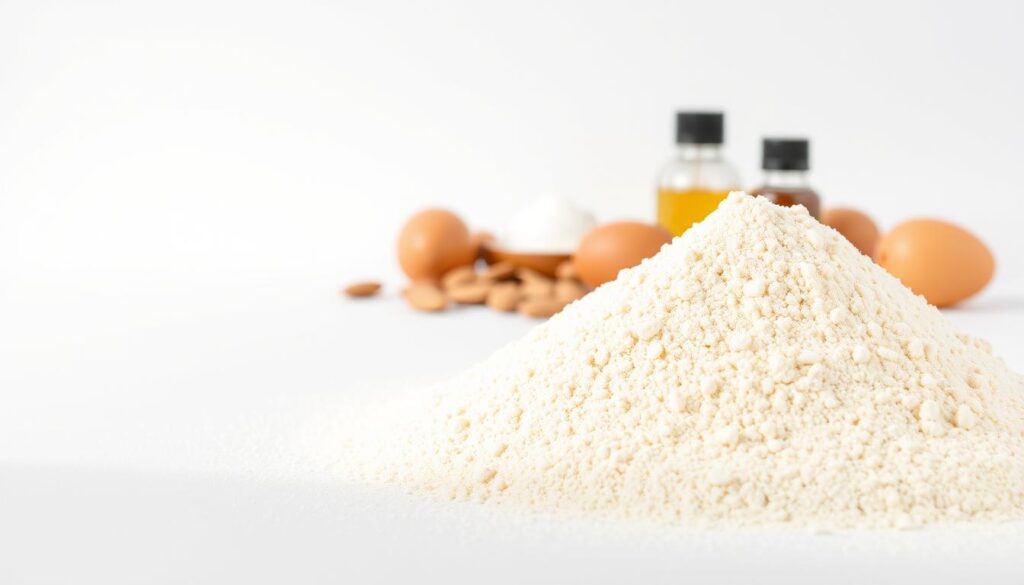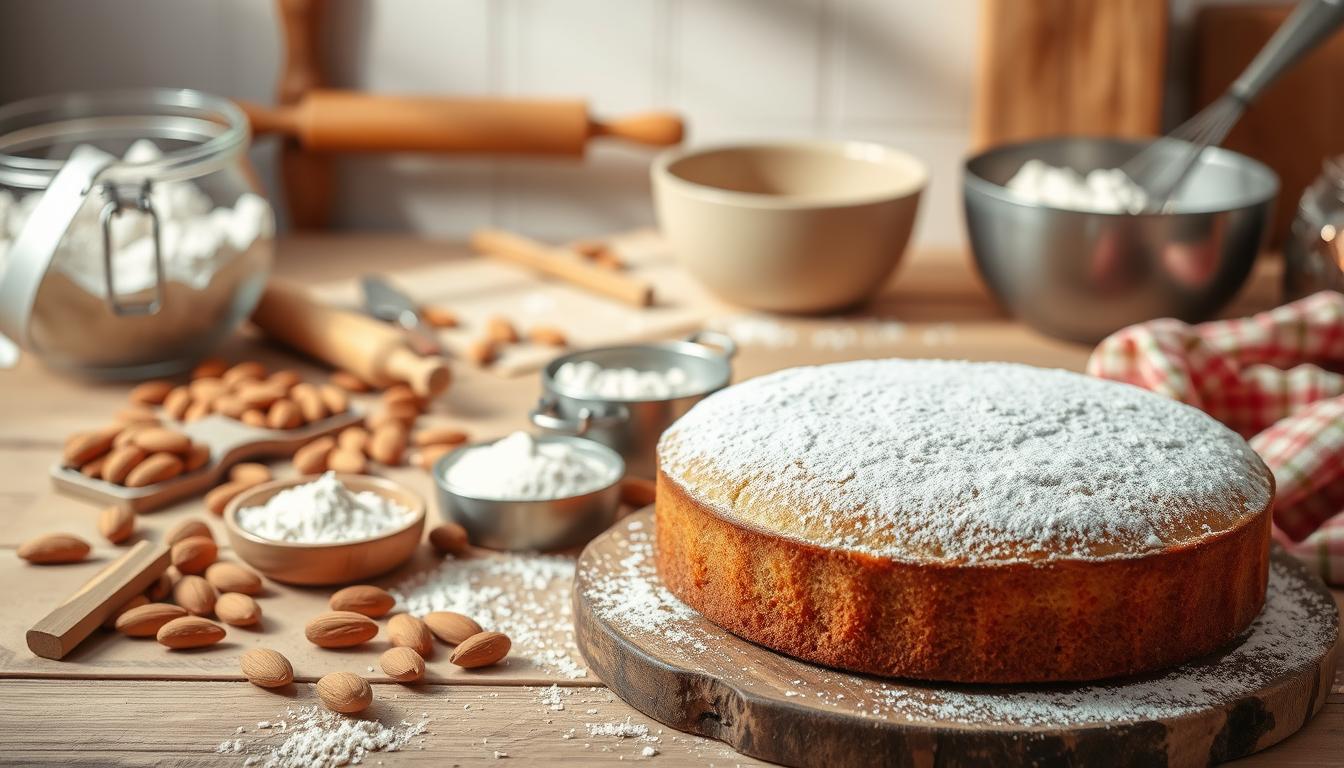Every time I stepped into my kitchen feeling frustrated with traditional baking, almond flour became my unexpected savior. As someone struggling with gluten sensitivities, discovering the magic of almond flour recipes cake transformed my baking experience completely. Gluten-free baking no longer meant sacrificing taste or texture.
This guide will unlock the secrets of creating delectable cakes using almond flour. Whether you’re a seasoned baker or a curious newcomer, you’ll discover how to craft moist, flavorful cakes. These cakes will tantalize your taste buds and meet dietary needs.
Almond flour isn’t just a substitute – it’s a game-changing ingredient that opens up a world of culinary possibilities. You’ll learn techniques to elevate your baking skills and create incredible gluten-free treats that everyone will love.
Key Takeaways
- Almond flour offers a nutritious alternative to traditional wheat flour
- Gluten-free baking can be delicious and satisfying
- Proper techniques are key for successful almond flour cakes
- Moisture management is key to perfect texture
- Almond flour provides additional nutritional benefits
Understanding Almond Flour and Its Benefits in Baking
Almond flour has changed the game for grain-free desserts. It’s a healthier and tasty choice compared to regular baking ingredients. As people look for better cake options, almond flour cakes are gaining popularity. They offer unique benefits and are good for your health.

Nutritional Powerhouse of Almond Flour
Choosing almond flour for your baking means picking a superfood. It’s full of vitamins and minerals. Compared to wheat flour, almond flour is a nutritional powerhouse:
- High in protein (up to 6 grams per 1/4 cup)
- Rich in vitamin E
- Contains heart-healthy monounsaturated fats
- Low in carbohydrates
- Gluten-free and grain-free
Unique Characteristics of Almond Flour
Almond flour is different from wheat flour. It has a fine texture and natural oils. This makes almond flour cakes incredibly moist and rich in flavor.
Health Benefits of Almond Flour Baking
Baking with almond flour has many health benefits. It helps manage blood sugar, gives you energy, and is good for your heart. For those looking for healthy options, almond flour cakes are a delicious choice.
Almond flour transforms ordinary baking into a nutritious culinary adventure.
Essential Tools and Equipment for Almond Flour Baking

Getting ready for baking with almond flour is more than just gathering ingredients. The right tools can make a big difference. They help you make delicious paleo cakes with ease.
Baking with almond flour needs precision and special tools. Your kitchen should have a few key items for perfect results:
- Digital kitchen scale for accurate measuring
- High-quality silicone baking mats
- Non-stick cake pans with removable bottoms
- Food processor for grinding fresh almond flour
- Sifter for removing almond flour clumps
Measuring tools are key for almond flour recipes. Unlike regular flour, almond flour needs precise measurements. A digital kitchen scale is your best tool for this.
For paleo cakes, get quality mixing bowls with non-slip bases. Ceramic or stainless steel bowls are best for keeping temperatures steady. Use silicone spatulas and whisks for smooth mixing without deflating the batter.
Tools like parchment paper liners and cooling racks can also improve your baking. They prevent sticking and help cakes cool evenly. This is important for moist, perfectly textured almond flour cakes.
Must-Know Almond Flour Recipes Cake Techniques
Mastering nut flour baking needs precision and special techniques. These differ from traditional wheat flour baking. Low-carb cake alternatives require careful attention for delicious results. Knowing almond flour’s unique properties helps make moist, tender cakes.
Successful almond flour baking depends on key techniques. These steps are vital for perfect low-carb cake alternatives.
Precise Measuring Methods
Almond flour needs different measuring techniques than wheat flour. Here are essential tips:
- Always use a light scooping method
- Level measurements with a straight edge
- Sift almond flour to remove clumps
- Weigh ingredients for maximum accuracy
Expert Mixing Techniques
Mixing almond flour batter needs a gentle touch. Overmixing can make cakes dense and tough.
- Fold ingredients gently and minimally
- Use a rubber spatula for even incorporation
- Stop mixing when ingredients are just combined
Temperature Control Strategies
Nut flour baking needs careful temperature management for perfect results.
| Baking Technique | Temperature Recommendation | Baking Time |
|---|---|---|
| Standard Cakes | 325°F | 25-35 minutes |
| Delicate Recipes | 300°F | 35-45 minutes |
| Dense Cakes | 350°F | 20-30 minutes |
By using these techniques, you’ll make amazing low-carb cake alternatives. They’re both delicious and nutritious. Remember, practice and patience are key to mastering nut flour baking.
Moisture Management in Almond Flour Cakes
Making perfect almond flour cakes is all about managing moisture. Almond flour is different from wheat flour, making it harder to get the right texture. To succeed with healthy cakes, you need to know how to balance moisture.
Creating moist almond flour cakes starts with choosing the right ingredients and techniques. Almond flour has more moisture than wheat flour. So, you must adjust your baking methods.
- Use liquid ingredients sparingly to prevent soggy textures
- Incorporate moisture-absorbing ingredients like coconut flour
- Experiment with binding agents to improve cake structure
- Control oven temperature to prevent over-drying
Techniques for managing moisture can turn your almond flour cakes into tender delights. Here are some strategies to try:
| Technique | Moisture Impact |
|---|---|
| Psyllium husk | Absorbs excess liquid, improves texture |
| Egg whites | Adds moisture without heaviness |
| Greek yogurt | Provides creamy moisture |
Professional bakers say it’s key to track moisture levels when baking almond flour cakes. Even small changes can greatly affect your cake. By mastering these moisture management tips, you’ll make delicious, moist cakes that are just as good as traditional ones.
Best Sweeteners and Binding Agents for Almond Flour Cakes
Creating delicious gluten-free baking recipes is all about the right ingredients. Your cake’s success depends on the perfect sweeteners and binding agents. These should complement almond flour’s unique properties.
Finding the right ingredients for almond flour baking is key. It’s about making moist, delicious treats that everyone can enjoy. The right mix of ingredients can turn your gluten-free desserts into something amazing.
Natural Sweetener Options
When baking with almond flour, choose sweeteners that enhance its nutty flavor and add moisture. Here are some top natural sweetener choices:
- Honey – adds moisture and rich flavor
- Maple syrup – provides natural sweetness
- Coconut sugar – creates depth of flavor
- Stevia – offers a low-calorie alternative
Egg Substitutes and Alternatives
For those avoiding eggs, there are many ways to make almond flour desserts delicious. Try these binding alternatives:
- Chia seeds mixed with water
- Mashed bananas
- Applesauce
- Flaxseed meal
Binding Agents for Structure
Almond flour lacks gluten, so you’ll need extra binding agents for the right cake texture. Here are some effective options:
- Xanthan gum – provides elasticity
- Psyllium husk powder
- Arrowroot starch
- Gelatin (for non-vegan recipes)
Experimenting with these ingredients will help you master gluten-free baking. You’ll create mouthwatering almond flour desserts that everyone will love.
Converting Traditional Cake Recipes to Almond Flour
Changing your favorite cake recipes to use almond flour can be tricky. It’s important to know how almond flour is different from wheat flour. Almond flour adds special qualities that need adjustments to make your cakes moist and tasty.
To convert traditional cake recipes, you’ll need to make a few key changes:
- Reduce liquid ingredients by 20-25%
- Add extra binding agents like eggs or xanthan gum
- Lower baking temperature by 25 degrees
- Decrease baking time to prevent over-drying
Measuring ingredients accurately is key when using almond flour. Almond flour lacks gluten, so your cake’s texture depends on your mixing skills. Make sure to measure ingredients precisely and mix them carefully for the right texture.
| Wheat Flour | Almond Flour Substitution | Recommended Adjustment |
|---|---|---|
| 1 cup wheat flour | 1 cup almond flour | Reduce liquid by 1/4 cup |
| 2 eggs | 2 eggs + 1 tbsp arrowroot | Improve binding |
| Regular baking temp | 25 degrees lower | Prevent burning |
Trying out almond flour recipes takes time and patience. Begin with small batches and keep detailed notes. With practice, you’ll get better at making gluten-free desserts that are both healthy and delicious.
Troubleshooting Common Almond Flour Cake Issues
Baking almond flour cakes can be tricky, but you can solve common problems. Knowing what to watch out for helps you make tasty grain-free desserts. It’s all about mastering the art of baking with almond flour.
Texture Challenges and Solutions
Almond flour cakes can have texture issues. These problems can make your desserts less than perfect. Here are some solutions to common texture problems:
- Grainy Texture: Sift your almond flour well before mixing to avoid clumps
- Choose ultra-fine almond flour for a smoother texture
- Add a bit of xanthan gum to improve the texture
Rising and Stability Concerns
Getting the right rise in almond flour cakes needs special techniques. It’s important to know how almond flour differs from wheat flour.
| Issue | Solution |
|---|---|
| Flat Cake | Use extra eggs or baking powder to increase volume |
| Dense Texture | Separate eggs and whip whites before folding |
| Uneven Baking | Use light-colored metal pans and rotate midway |
Storage and Freshness Tips
Storing your almond flour cakes right is key to keeping them fresh. Follow these tips to keep your grain-free desserts tasty:
- Cool completely before storing
- Wrap tightly in plastic wrap or store in airtight container
- Refrigerate for up to 5 days
- Freeze for longer storage (up to 3 months)
By using these troubleshooting tips, you’ll make almond flour cakes with great texture, perfect rise, and lots of flavor every time.
Decorating and Frosting Tips for Almond Flour Cakes
Making beautiful and tasty healthy cakes with almond flour needs special skills. The cake’s special texture means you must decorate and frost it carefully.
First, make sure your frosting base is smooth. Almond flour cakes are delicate, so frost them gently. Here are some decorating tips:
- Chill the cake before frosting to create a more stable surface
- Use a thin layer of frosting as a crumb coat
- Choose frostings that complement almond flour’s nutty flavor
For cakes with less sugar and no dairy, try new frosting ideas. Coconut cream frosting and cashew-based spreads are great with almond flour cakes.
Decorating can make your almond flour desserts look amazing:
- Pipe delicate rosettes around the cake’s edges
- Sprinkle toasted nuts for texture and visual appeal
- Use fresh berries or edible flowers as elegant garnishes
Almond flour cakes need gentle care. Your decorating should highlight the cake’s texture while making it look and taste great.
Seasonal Variations and Flavor Combinations
Make your almond flour recipes cake even better by trying new seasonal flavors. Paleo cake recipes can change with the seasons and flavors. Get creative with gluten-free baking and show off almond flour’s natural taste.
Seasonal baking is like an art. It lets you use fresh ingredients and unique tastes. Your almond flour cakes can be true works of art, showing off the best of each season.
Summer Fruit Variations
Summer is the perfect time for fresh ingredients in your almond flour recipes cake. Try these tasty mixes:
- Peach and lavender cake with a light almond crumb
- Strawberry basil paleo cake with a delicate texture
- Tropical mango and coconut almond flour cake
Holiday-Specific Adaptations
Change your paleo cake recipes for holidays. Each season offers a chance to make special desserts:
- Pumpkin spice almond flour cake for autumn
- Peppermint chocolate almond flour cake for winter holidays
- Lemon rosemary cake for spring gatherings
Complementary Flavors Guide
Knowing how to mix flavors can make your almond flour cakes amazing. Try these classic and new flavor pairs:
- Citrus and herbs
- Chocolate and chili
- Vanilla and lavender
- Honey and thyme
Your almond flour recipes cake is a blank canvas for creativity. Use seasonal ingredients, try new flavor mixes, and let your baking dreams come true!
Conclusion
Your journey into almond flour baking has given you the skills to make tasty low-carb cakes. You now know how to turn old recipes into healthier, tasty desserts. These desserts don’t lose out on flavor or texture.
Every technique you’ve learned, from managing moisture to swapping out ingredients, lets you get creative in the kitchen. Almond flour is a great base for making cakes that are good for your diet but also delicious. These skills are perfect for making gluten-free treats or trying new recipes.
Learning to bake with almond flour takes time and practice. Start with the basics, be patient, and don’t worry about mistakes. As you bake more, you’ll get better and make desserts that impress everyone.
Use almond flour’s versatility to let your baking imagination run wild. With your new knowledge, making desserts will be fun and healthy. You’ll see that eating well doesn’t have to mean missing out on flavor.

